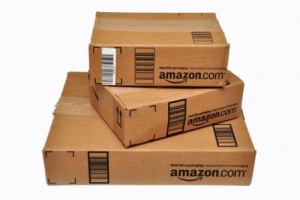Many investors are looking at the steep skid Alibaba Group Holding Ltd. (NYSE: BABA) has taken since its IPO as a major cause for concern.
But for us, this is only an opportunity.
Because Alibaba stock represents an opportunity to create the kind of wealth that you'll be able to pass along to future generations.
That makes the Chinese e-commerce giant what I call a "Piggybank Investment." Essentially, whenever you fill up your piggybank (or a jar you store on the closet shelf) you scoop up the change and put it into Alibaba.
Today, I'll show you how "Piggybank Investing" works.
It takes just a few pennies at a time...
"Gloom" Is Opportunity
To fully explain "Piggybank Investments," it would help to take a closer look at Alibaba's closest American counterpart.
 So let's go back 17 years, to the day, and see where shares of Amazon.com Inc. (Nasdaq: AMZN) were trading.
So let's go back 17 years, to the day, and see where shares of Amazon.com Inc. (Nasdaq: AMZN) were trading.
Amazon went public on May 15, 1997, at $18 a share. But thanks to three stock splits that took place in the late 1990s, the adjusted Amazon IPO price works out to $1.50 a share.
On April 9, 1998, Amazon closed at $7.94.
Fast-forward 17 years. Today, Amazon opened at $384.31. That's a 4,740.2% increase in 17 years.
For purposes of comparison, Amazon is a terrific "peer" company for Alibaba.
And you can see the profit potential when a well-chosen and well-timed investment such as Amazon - or Alibaba - is held for the long run.
Transformers
Amazon and Alibaba are examples of firms so revolutionary that they change the way business in their sector is conducted.
They even change consumer behavior.
True transformational companies are a rarity - which is why the payoff is so huge.
Amazon - along with eBay Inc. (Nasdaq: EBAY) and other retailers jumping online along with them - changed the way America shops. First off, they practically invented e-commerce - and changed the landscape of our malls and strip centers.
And now Amazon has become much more than a retailer. Instead of competing against Borders, Caldor and Pets.com, it's going up against Apple Inc. (Nasdaq: AAPL) and Google Inc. (Nasdaq: GOOG, GOOGL). It's doing so by buying up every part of the value chain - and then creating a tech "ecosystem" that you never have to leave.
By emerging when it did, Amazon displayed impeccable timing.
Amazon achieved its own "critical mass" just as the Internet did in the United States.
Here's how Alibaba has the same opportunity...
It's gaining traction in its home market in China just as that country's people are truly joining the Internet revolution. And the development of easy-to-use mobile commerce is giving Alibaba a strong tailwind.
In a report from last year, analysts at the Australia and New Zealand Banking Group Ltd. said that China last year leapfrogged the United States to become the No. 1 online marketplace in the world. Online shopping there reached $298 billion in 2013, easily surpassing U.S. sales of $263 billion.
And the growth rate is dizzying: According to German research firm yStats, China's consumer e-commerce market soared more than 60% in 2013.
Because of the striking parallels between the U.S. and Chinese scenarios, I believe Alibaba could be the single-greatest wealth opportunity of our lifetime.
Just take another look at what the fortune you could have built if you invested in Amazon 17 years ago.
And that brings us to the Piggybank Investment strategy I referred to.
Pennies at a Time
Alibaba is a stock that you want to own for the long haul.
[epom key="ddec3ef33420ef7c9964a4695c349764" redirect="" sourceid="" imported="false"]
But it is not a "back-up-the-truck" stock.
You want to accumulate shares over time, using sell-offs as opportunities to add to your holdings.
And you can do this for pennies - even at $85 a share.
Thanks to the way discount and online brokerages have revolutionized trading for retail investors - slashing fees and taking away the onus of buying shares in "odd lots" - you can start picking up shares of Alibaba in ones, twos, or threes - or more.
Designate an "Alibaba" piggybank, or a jar, and start dropping your spare change in it. It adds up quickly - you'll be surprised.
And every time you get enough to pick up a share or two - do it. Every time Alibaba sells off, snap up more of the company's stock.
Just keep accumulating the shares - and let your investment ride... without stop losses or trailing stops.
I typically don't advocate this approach. But I believe Alibaba has a very real chance of becoming a "legacy stock" for you - one your grandkids will thank you for.
Your grandkids would also be thanking you if you were allowed to invest in Amazon or Alibaba before their IPOs. Your gains would have been even bigger - a lot bigger.
When it comes to the pre-IPO market, retail investors like us are locked out - except in a single noteworthy case. And for the past several months, I've been putting together a deal that lets my readers in on that one exception.
This deal won't be available much longer, so if you haven't investigated it yet, I hope you do so today. This single investment gives you the opportunity to earn the kind of profits that only venture capitalists and hedge funds could make before.
But now, they're "fair game." Click here for more information.
I'm leaving you, honey. And I'm taking the kids... We've got a great way to profit from a corporate "divorce." Because the payments industry is quickly becoming its own sort of sector and it just so happens a "legacy" tech firm is planning to spin off its much faster-moving payments unit later this year. This means one thing: juicy profits for you and me.
About the Author
Michael A. Robinson is a 36-year Silicon Valley veteran and one of the top tech and biotech financial analysts working today. That's because, as a consultant, senior adviser, and board member for Silicon Valley venture capital firms, Michael enjoys privileged access to pioneering CEOs, scientists, and high-profile players. And he brings this entire world of Silicon Valley "insiders" right to you...
- He was one of five people involved in early meetings for the $160 billion "cloud" computing phenomenon.
- He was there as Lee Iacocca and Roger Smith, the CEOs of Chrysler and GM, led the robotics revolution that saved the U.S. automotive industry.
- As cyber-security was becoming a focus of national security, Michael was with Dave DeWalt, the CEO of McAfee, right before Intel acquired his company for $7.8 billion.
This all means the entire world is constantly seeking Michael's insight.
In addition to being a regular guest and panelist on CNBC and Fox Business, he is also a Pulitzer Prize-nominated writer and reporter. His first book Overdrawn: The Bailout of American Savings warned people about the coming financial collapse - years before the word "bailout" became a household word.
Silicon Valley defense publications vie for his analysis. He's worked for Defense Media Network and Signal Magazine, as well as The New York Times, American Enterprise, and The Wall Street Journal.
And even with decades of experience, Michael believes there has never been a moment in time quite like this.
Right now, medical breakthroughs that once took years to develop are moving at a record speed. And that means we are going to see highly lucrative biotech investment opportunities come in fast and furious.
To help you navigate the historic opportunity in biotech, Michael launched the Bio-Tech Profit Alliance.
His other publications include: Strategic Tech Investor, The Nova-X Report, Bio-Technology Profit Alliance and Nexus-9 Network.



